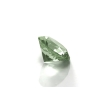|
 Beryl is
not a single stone, this name refers to the whole family of minerals which also
includes blue aquamarine, dark green emeralds, golden heliodor, yellowish-green
chrysoberyl, chameleonic alexandrite (it changes color from red-purple under
artificial lighting to green in daylight), pink or peach morganite, and bluish-green
euclase. The gemstones of the beryl family were mentioned by Pliny the Elder
and Theophrastus. Beryl is
not a single stone, this name refers to the whole family of minerals which also
includes blue aquamarine, dark green emeralds, golden heliodor, yellowish-green
chrysoberyl, chameleonic alexandrite (it changes color from red-purple under
artificial lighting to green in daylight), pink or peach morganite, and bluish-green
euclase. The gemstones of the beryl family were mentioned by Pliny the Elder
and Theophrastus.
Beryl has
been mined since ancient times and it was reportedly used as eyeglass lenses in
Ancient Rome and as the lens that Emperor Nero viewed gladiator fights with.
Ancient legends suggest that beryl was the treasure of the mermaids and that
seahorses carried these beautiful stones from the treasure chests to the
inhabited shores where humans could find them.
However,
when asserting that beryls were known since ancient times, one should remember
that the name «berillos» in ancient Greece referred to any translucent green
gemstone, and at that time, green beryls were called chrysolites and clear
beryls were often labeled as quartz.
This
terminological confusion is corroborated by Pliny who wrote: «beryl is believed
to have the same nature as the emerald or, at least, is very similar to it».
That means, in Pliny's opinion, emerald and beryl are two different gemstones.
The greatest
beryl-related confusion involves the notorious Emperor Nero. He is believed to
have viewed gladiator fight using an emerald eyeglass. This «monocle» is mentioned
by many ancient authors. For a long time, it was believed that Nero's eyeglass
was made of huge emerald. The descriptions of the great fire of Rome in fiction
are incomplete without the picture of Nero standing on the hill and observing the
city in flames through the giant emerald crystal, or through the «emerald glass».
Spacious arenas and the spectacular executions, feasts and beautiful women - Emperor
Nero observed the reality through his luxury emerald eyeglass. This eyeglass is
stored in the Vatican Museum, but modern mineralogists who examined the stone found
out that this was not an emerald, but a high-quality chrysolite.
In the
Middle Ages, a transparent, colorless beryl was used to make optical glass,
therefore the German word «brille» means «eyeglasses».
Beryl crystals
vary in size, depending on the variety of stone. For example, in South Dakota 8.5 meter long beryl crystal
weighing over 61 tons was found. In 1910 in Brazil, a greenish-blue damaged beryl crystal,
48.3 x 41 cm,
weighing 110.2 kg
was found. The surprising thing was that it was absolutely clear! Some time later,
a smaller crystal weighing a little more than 5 kg was found exactly in the
same mine. The museum of Saint-Petersburg Mining Institute exhibits a beryl
crystal of clear yellow-green hue, found in the Urals in 1828. It weights more
than 2.5 kg.
This gemstone was valued at 4800 gold rubles.
Most often,
these large crystals are not of high quality and can not be viewed as precious
stones. For example, in the Spanish province of Galicia similar beryl crystal
were used for door frames. From ancient times, beryls have been widely used in
lithotherapy (treatment with stones), but when «prescribing" beryl
therapy, modern litotherapy professionals should remember that in ancient
recipes by green stones they rarely meant beryls as we know them today.
However, if
you're determined to follow the ancient recipes, beryls are mainly used to
treat various women's diseases (for example, beryl ring prevents the descent of
womb, while beryl bracelets protect against bladder and ovary dysfunction).
Beryl earrings can be worn by both men and women to cure headache or toothache.
It's a pity men rarely don jewelry. Beryl necklaces are good for curing respiratory
disease and nervous disorders.
There is a
popular belief that beryls help to promote conjugal happiness and resolve the eternal
dispute between fathers and sons. Also, they are said to prevent the inflow of
negative energy and bring benevolent peace.
However, it
should be borne in mind that alexandrite, another stone in the beryl family, is
considered to be a «widow's stone». And the name itself has quite a sinister
meaning. It was believed that if a married woman dons a single alexandrite (for
example, one alexandrite ring) she has every chance to become a widow in the
nearest future. To counteract this effect of alexandrite, you should don two
alexandrite pieces (two rings, or a ring and earrings, earrings and a bracelet).
Beryl is
also attributed one charming property that may be quite useful in the recession
times. It is believed that these stones protect the stability of financial and
professional status of its owner. In order to avoid dismissal, you need to wear
beryl jewelry, talk to your boss, and you won't be dismissed.
To avoid
the threat of bankruptcy and impoverishment, you should wear beryl jewelry for
your interview with the debt-collector. Today, dismissal and cutting down, as
well as bankruptcy and ruin due to financial and economic crisis are quite
common, so beryls could be quite popular due to their miraculous properties if it
wasn't for their price - these gemstones are far from cheap.
|